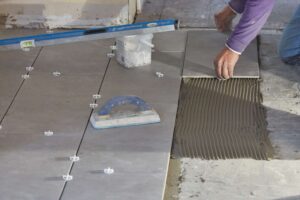Here at our team, we’ve got the inside scoop on whether you can lay flooring on top of existing flooring.
If you’re looking to give your space a fresh new look without the hassle of removing the old floor, we’ve got you covered.
In this article, we’ll explore the types of flooring that can be installed over existing surfaces, important factors to consider before diving in, and step-by-step instructions for a successful installation.
So let’s dive in and uncover the secrets of laying flooring on flooring!
Key Takeaways Can You Lay Flooring on Flooring
- Certain types of flooring can be installed over existing flooring, saving time and money.
- Thoroughly assess the condition of the current floor before deciding on alternative flooring options.
- Material compatibility is crucial to prevent issues like warping or buckling.
- Consider the weight-bearing capacity and moisture damage of the existing floor before installing new flooring.
Types of Flooring That Can Be Installed Over Existing Flooring
You can definitely install certain types of flooring over existing flooring. When considering this option, it’s essential to weigh the pros and cons of layering flooring.

One advantage is that it saves time and money since you don’t need to remove the old floor completely. Additionally, it allows for quick and easy installation without disrupting your daily routine.
However, there are some potential downsides to consider as well. Layering flooring may result in a higher floor height, which could cause issues with door clearance or transitions between rooms. Furthermore, if the existing floor has any imperfections or damage, these may be transferred to the new layer of flooring.
It’s crucial to thoroughly assess the condition of the current floor before deciding on alternative flooring options that can be installed over it.
Factors to Consider Before Installing Flooring on Flooring
Before installing flooring on top of existing flooring, there are two key factors to consider: compatibility of materials and structural integrity concerns.

Ensuring that the new flooring is compatible with the existing material is crucial to prevent any issues such as warping or unevenness.
Additionally, it is important to evaluate whether the structure can support the additional weight of multiple layers of flooring without compromising its integrity.
Taking these factors into account will help ensure a successful installation and long-lasting results.
Compatibility of Materials
Laying flooring on top of existing flooring can be a viable option if the materials are compatible. When considering compatibility concerns and installation techniques, there are several factors to keep in mind:

- Material compatibility: Ensure that the new flooring material is compatible with the existing one to prevent issues like warping or buckling.
- Thickness considerations: Take into account the thickness of both layers to ensure they won’t cause problems with door clearances or transitions between rooms.
- Subfloor condition: Check the condition of the subfloor beneath the existing flooring. Any damage or unevenness should be addressed before installing new flooring.
- Installation method: Depending on the type of new flooring and its compatibility with the existing one, different installation techniques may need to be employed, such as floating floors or glue-down methods.
Considering these factors will help ensure a successful installation process while maintaining structural integrity for your space.
Structural Integrity Concerns
When installing new flooring on top of existing materials, it’s important to consider the structural integrity concerns to ensure a safe and stable environment. As professionals in the industry, we understand the significance of avoiding moisture damage and maintaining warranty coverage during this process.
One major concern is the weight-bearing capacity of the existing floor. Adding another layer of flooring can increase the load on the structure, potentially causing issues if it exceeds its limits. It’s essential to assess whether the current subfloor can handle the additional weight without compromising its stability.
Moisture is another critical factor that must be addressed. If there are any signs of water damage or excessive moisture in the existing flooring, it’s crucial to address these issues before proceeding with installation. Failure to do so can result in long-term problems, such as mold growth or warping.
Furthermore, when laying new flooring over existing materials, it’s vital to follow manufacturer guidelines to maintain warranty coverage. Deviating from their recommendations could void any guarantees or protections provided by them.
Preparation Steps for Installing New Flooring Over Existing Flooring
You can easily install new flooring over existing flooring with proper preparation steps. Here are some factors to consider and tips for success:
- Evaluate the condition: Check the current flooring for any signs of damage or wear. Make sure it is stable and level before proceeding.
- Clean thoroughly: Remove any dirt, dust, or debris from the existing flooring surface. This will ensure a smooth installation and proper adhesive bonding.
- Repair as needed: Address any issues such as loose boards, cracks, or uneven areas before installing the new flooring. This will prevent future problems and ensure a long-lasting result.
- Choose compatible materials: Consider factors like thickness, type, and installation method when selecting your new flooring to ensure compatibility with the existing floor.
By following these preparation steps, you’ll set yourself up for a successful installation process.
Now let’s move on to discussing the tools and materials needed for installing flooring on top of existing flooring.
Tools and Materials Needed for Installing Flooring on Flooring
Now that we have discussed the preparation steps for installing new flooring over existing flooring, let’s move on to the tools and materials needed for this project.
When it comes to laying flooring on top of existing flooring, there are a few essential tools and techniques that can make the process easier.
Firstly, you will need a good quality underlayment, which will provide a smooth and stable surface for your new flooring. Additionally, you will require basic hand tools such as a tape measure, utility knife, hammer, pry bar, and a rubber mallet. These tools will help you remove any obstacles or trim pieces that may be in the way.
While there are many benefits to installing new flooring over existing flooring—such as saving time and money—there are also some cons to consider. One potential drawback is the added height that comes with layering multiple floors. This can create challenges in doorways or transitions between rooms.
Overall, with the right tools and techniques in place, laying new flooring over existing flooring can be a feasible option for homeowners looking to update their space without starting from scratch.
Step-by-Step Guide to Installing New Flooring on Existing Flooring
To begin installing new flooring on existing flooring, start by gathering all the necessary tools and materials. Here are four items you’ll need to ensure a successful installation:
- Underlayment: This thin layer helps smooth out any imperfections in the existing carpet and provides a barrier between the old and new flooring.
- Adhesive: Depending on the type of flooring you choose, you may need adhesive to secure it in place. Make sure to select an adhesive that is suitable for both the existing carpet and the new flooring material.
- Transition Strips: These strips are essential for creating a seamless transition between different types of flooring. They not only enhance the aesthetic appeal but also provide safety by preventing tripping hazards.
- Tools: Don’t forget to gather basic tools such as a measuring tape, utility knife, hammer, and pry bar for removing any trim or molding.
While it is possible to lay new flooring over existing carpet yourself, hiring a professional for this task has several benefits. Professionals have experience working with different types of flooring and can ensure proper installation techniques are used. They also have access to specialized tools and equipment that can make the process more efficient and precise. Additionally, professionals can offer advice on choosing the right type of flooring that can be installed over carpet while still achieving your desired look and functionality.
Common Mistakes to Avoid When Laying Flooring on Flooring
When it comes to laying flooring on top of existing flooring, proper preparation is key.
We have found that taking the time to thoroughly clean and level the surface before installation can prevent future issues such as gaps or unevenness.
It is crucial to avoid uneven surfaces as they can cause problems with stability and durability of the new flooring.
Proper Preparation Is Key
Proper preparation is key when laying flooring on top of existing flooring. It is crucial to take the necessary steps to ensure compatibility and avoid potential damage. Here are four important factors to consider:
- Assess the existing floor: Thoroughly examine the condition of the current flooring, looking for any signs of wear, moisture, or structural issues that may affect the installation process.
- Clean and level: Remove any debris, dust, or adhesive residue from the surface before installing new flooring. Additionally, ensure that the subfloor is perfectly level to prevent unevenness and future problems.
- Choose appropriate materials: Select flooring materials that are compatible with each other in terms of thickness, expansion rates, and installation methods. This will help minimize compatibility issues during installation.
- Proper underlayment: Install a suitable underlayment between layers of flooring to provide cushioning, sound insulation, and moisture protection.
By following these guidelines for proper preparation, you can avoid compatibility issues and potential damage while laying flooring on top of existing surfaces.
Now let’s explore how to avoid uneven surfaces when undertaking this project.
Avoid Uneven Surfaces
Avoiding uneven surfaces is essential for a successful installation of new floors. When it comes to laying flooring on existing flooring, it’s crucial to ensure that the surface is level and smooth. By doing so, you can avoid potential problems down the line, such as floor damage or an uneven appearance.
Removing existing flooring before installing new floors offers several benefits. Firstly, it allows you to assess the condition of the subfloor and make any necessary repairs or adjustments. Secondly, removing old flooring gives you the opportunity to clean and prepare the surface properly, ensuring better adhesion for the new material. Lastly, starting with a fresh substrate can help prevent issues like squeaks or shifting over time.
| Benefits of Removing Existing Flooring |
|---|
| 1. Assess subfloor condition |
| 2. Make necessary repairs |
| 3. Clean and prepare surface |
| 4. Prevent future problems |
By taking these steps to avoid uneven surfaces and remove existing flooring when necessary, you set yourself up for a more successful installation overall.
In the next section, we will explore the pros and cons of installing new flooring over existing flooring
Pros and Cons of Installing New Flooring Over Existing Flooring
Installing new flooring over existing flooring can be a convenient option, but it may also have some drawbacks. Here are four considerations to keep in mind when deciding whether to lay new flooring on top of the old.
- Compatibility: Before installing new flooring, it’s essential to assess its compatibility with the existing floor. Different materials may not adhere well together, leading to issues like uneven surfaces or premature wear and tear.
- Cost Effectiveness: While laying new flooring over existing flooring can save money by avoiding the cost of removing the old floor, it’s crucial to consider long-term costs. If the existing floor is damaged or incompatible, it may require additional repairs or replacement sooner than anticipated.
- Height Increase: Adding another layer of flooring can lead to an increase in overall height. This could affect door clearance, transitions between rooms, and even cause tripping hazards if not properly addressed.
- Subfloor Condition: The condition of the subfloor plays a significant role in determining whether installing new flooring over existing floors is feasible. If there are structural issues or moisture problems with the subfloor, they must be addressed before proceeding with installation.
Considering these factors will help ensure a successful and cost-effective project when deciding whether to install new flooring over existing floors.
Tips for Ensuring a Successful Flooring Installation on Existing Flooring
When considering a successful installation on existing flooring, it’s important to assess the condition of the subfloor. At our company, we understand that there are common problems that can arise when laying new flooring on top of existing flooring.
One common issue is unevenness in the subfloor, which can cause the new flooring to become unstable and lead to premature wear and tear. To avoid this problem, it is best practice to level the subfloor before installation.
Another common problem is moisture trapped beneath the existing flooring, which can lead to mold growth and damage over time. To prevent this issue, it is recommended to test for moisture and address any issues before installing new flooring.
Frequently Asked Questions About Installing Flooring on Flooring
When considering installing flooring on top of existing flooring, there are several factors to consider.
It’s important to be aware of common installation mistakes that can lead to problems down the line.
Here are some frequently asked questions about this topic:
- Will the new flooring add too much weight? Ensure that your subfloor can support the additional weight before proceeding with the installation.
- What type of flooring is currently in place? Different types of existing flooring may require different installation methods or may not be suitable for layering.
- Are there any height restrictions? Adding a new layer of flooring can affect door clearance and transitions between rooms, so it’s crucial to take measurements and plan accordingly.
- Have you properly prepared the existing flooring? Thoroughly clean and level the surface before laying the new floor to avoid unevenness or damage.
Frequently Asked Questions
Is It Necessary to Remove the Existing Flooring Before Installing New Flooring Over It?
It is necessary to remove the existing flooring before installing new flooring over it. This ensures a proper installation, prevents issues with height differences, and allows for an even surface when installing laminate flooring over concrete.
Can I Install Hardwood Flooring Over Existing Carpet?
Yes, we can install hardwood flooring over existing carpet. However, it’s important to consider the pros and cons. While it may save time and money, it can lead to uneven surfaces and reduced durability.
What Should I Do if There Are Damaged Areas in the Existing Flooring?
To repair damaged areas in existing flooring, we can explore alternative solutions such as patching or replacing the damaged sections. It is important to assess the extent of the damage and consult a professional for guidance.
How Does Installing New Flooring Over Existing Flooring Affect the Height of the Room?
Installing laminate flooring over concrete can significantly impact the height of a room. This change in height may affect furniture placement and overall aesthetics. It’s crucial to consider these factors before deciding whether to lay new flooring on existing flooring.
Can I Install Vinyl Plank Flooring Over Existing Tile?
Yes, you can install vinyl plank flooring over existing tile. It offers several benefits such as convenience and cost-effectiveness. By layering the new flooring on top of the old, you can create a fresh, updated look without the hassle of removing the existing tile.
Conclusion
After considering all the factors and going through the step-by-step guide, it is clear that installing new flooring over existing flooring is a viable option.
However, before taking the plunge, there are precautions to be taken and mistakes to avoid. With proper preparation and the right tools, this project can transform your space.
The pros of saving time and money are enticing, but keep in mind the cons such as added height and potential issues with doors.
So, before you embark on this journey, make sure you have all the information needed for a successful installation.




